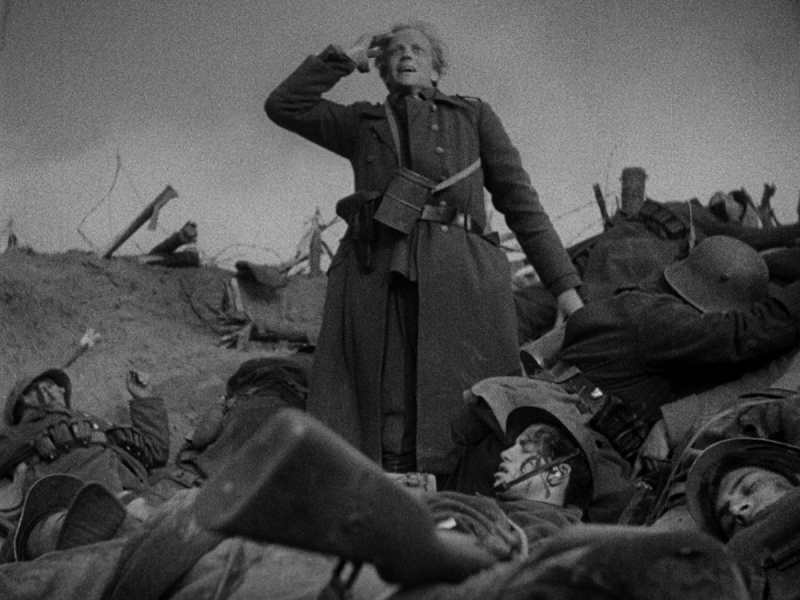The French film director Jean Cocteau declared that, “A film is a petrified fountain of thought.” His assertion explains why some films seem dated today; ideas fall out of vogue. Today, GW Pabst’s “Westfront 1918” seems hopelessly naïve. The 1931 film focuses on a cohort of four soldiers fighting in France at the end of World War I. These men have no instinct for self-preservation. They stick together regardless of the costs. Furthermore, by illuminating the horrors of war, Pabst proliferates a pacifist doctrine. Towards the end of the film, a wounded soldier expresses hope that after World War I is fought, people will shed their amity towards one another. Two years after the film was released, however, Adolf Hitler became chancellor of Germany. Another world war became inevitable.
Yet, even if Pabst’s philosophy seems antiquated, 100 years after the armistice, “Westfront 1918” is still captivating. In pressing for peace, Pabst unflinchingly documents the atrocities of war. While the narrative is episodic, Pabst is able to create real human drama. Ultimately, “Westfront 1918” reminds us that World War I was not simply a historic event; it affected millions of lives. While Pabst made the film 13 years after the conflict had ended, even this accomplished auteur could not come to terms with its consequences.
In some sense, Pabst was a strange director for this savage story of war. He had achieved renown by making expressionistic melodramas. His most acclaimed film, “Pandora’s Box,” conveyed the sad saga of Lulu, a woman who changes men as quickly as the protagonists of “Westfront 1918” reload their guns. Unfortunately, one of her paramours is Jack the Ripper, and she is murdered. Pabst paid particular attention to the bizarre elements of Lulu’s milieu and drew stark contrasts between darkness and light.
While “Pandora’s Box” is highly stylized, “Westfront 1918” is filmed with unsparing realism. Everything on the battlefield is rendered in a murky gray. Smoke envelops all surroundings, and the vast, deep trenches make the individual soldiers seem insignificant. “Westfront 1918” was Pabst’s first sound film, but he does not rely on dialogue or music. Instead, the soundtrack is simply an unending barrage of artillery fire and confused shouts. Pabst does not need to resort to the theatrics of “Pandora’s Box” to craft a compelling tale. After all, the anguished screams of shellshocked victims are as bloodcurdling as any one of Jack the Ripper’s crimes.
Like “Pandora’s Box,” “Westfront 1918” features an adulteress. One of the soldiers returns home on leave and, upon walking into the bedroom, finds his wife sleeping with another man. Yet, while Lulu seeks to challenge societal mores, the soldier’s wife is just trying to support herself. Inflation has caused bread prices to rise, so she is in desperate need of money. Unskilled and uneducated, she has no choice but to become a prostitute. Because of the war, even an act of adultery can be morally justified. Just as thick, gray smoke obscures the battlefield, so it complicates traditional notions of right and wrong.
By calling attention to these complexities, Pabst echoed ideas that several writers had already expressed about the war. Just as Pabst made his reputation with “Pandora’s Box,” the young poet Wilfred Owen admired Romantic poets like John Keats and Lord Byron. Writers like Keats and Byron often concentrated on the supernatural and the sensational. When he arrived on the front lines, however, Owen realized that his idols’ mystical lines could not convey war’s abominations. Therefore, in his poetry, he avoided the flowery lyricism of the Romantics. His description of a gas attack in “Dulce et Decorum est” is haunting. Owen and his compatriots are “bent double, like old beggars under sacks, knock-kneed, coughing like hags.” After vividly describing the inhumanity of war, Owen exposes “the old lie” – Horace’s statement that it is good and honorable to die for your country. The war has called into question the classical foundations of Western civilization.
Tragically, Owen perished in the trenches. Still, his poetry has become an immortal declaration of war’s inhumanity. Pabst gives visual expression to Owen’s words. At the end of the film, he shows the wounded arriving at the hospital. A man, his face pale white and his hair tussled, stares lifeless into space. He can do nothing but scream. Two orderlies take his arms and drag him off camera to the hospital. Another man shouts “I’m blind!” with such anguish that Oedipus would be ashamed.
Owen also describes a wounded soldier in his poem and insists that the reader would work to stop to war “if in some smothering dreams, you too could pace behind the wagon that we flung him in, and watch the white eyes writhing in his face, his hanging face, like a devil’s sick of sin.” Pabst does include a scene in which two wounded soldiers link hands and call each other comrades. This may seem unduly optimistic. Yet, Pabst also allows us to “pace behind the wagon” and “watch the white eyes writhing in his face.” Therefore, this “petrified fountain of thought” becomes “a smothering dream.” The events depicted in “Westfront 1918” occurred a century ago, but the film provides access to them. We understand Pabst’s misguided hopes for the future even as he smothers us in the harsh realities of war.
Contact Amir Abou-Jaoude at amir2 ‘at’ stanford.edu.
